University of Westminster: Maximum Flow Algorithm Project and Analysis
VerifiedAdded on 2023/04/10
|9
|913
|366
Project
AI Summary
This project presents a Java implementation of the Ford-Fulkerson algorithm, a fundamental algorithm in graph theory used to solve the maximum flow problem. The solution includes corrected source codes for the implementation, incorporating a breadth-first search (BFS) to find augmenting paths in a residual graph, and a random graph generator. The code demonstrates the algorithm's steps, including updating residual capacities and calculating the maximum flow. Furthermore, the project provides a performance analysis of the implementation, discussing its time complexity, which is O(EV^2) for Edmonds-Karp implementation, and its representation using an adjacency matrix which results in O(EV^3) time complexity. The assignment provides a detailed explanation of the code and the algorithm's performance characteristics.
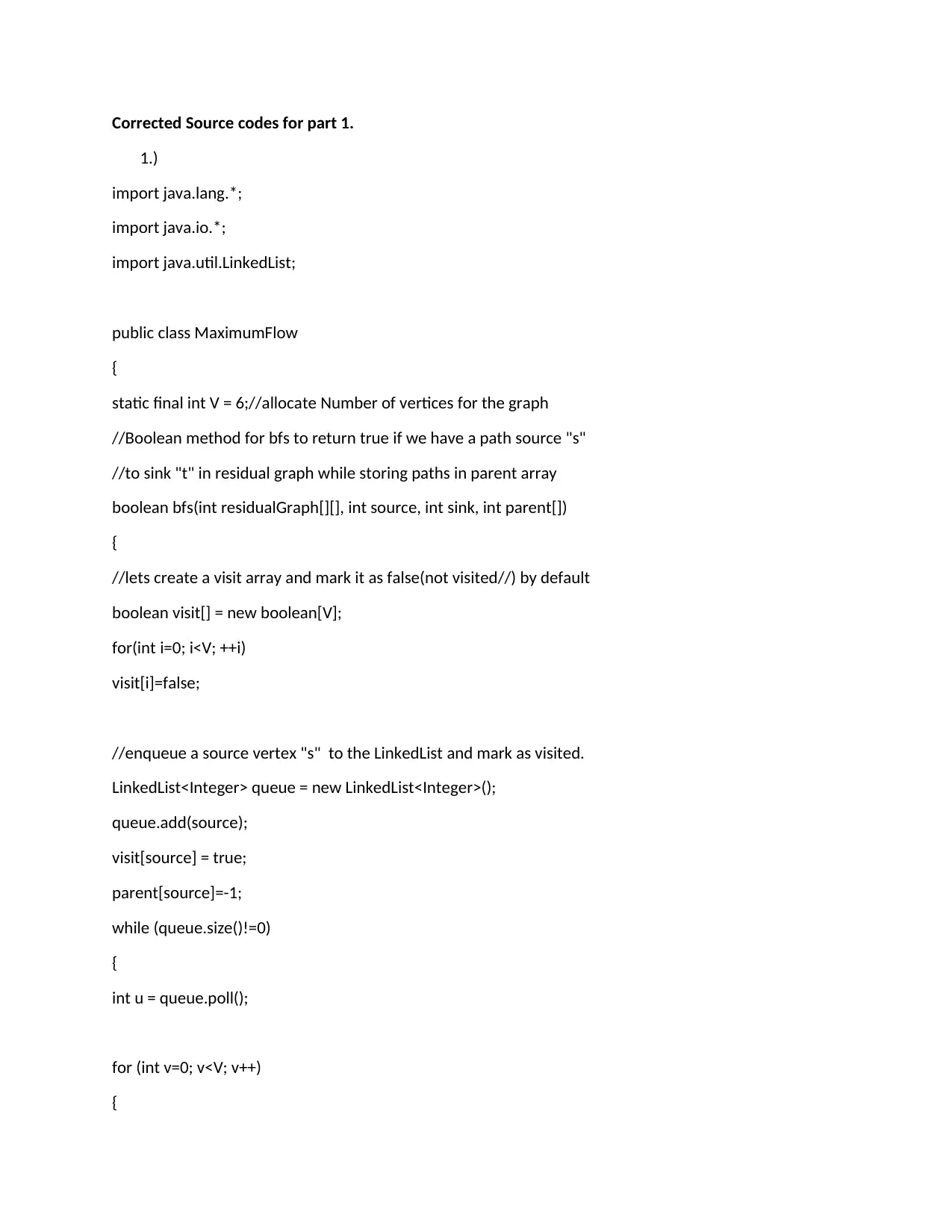
Corrected Source codes for part 1.
1.)
import java.lang.*;
import java.io.*;
import java.util.LinkedList;
public class MaximumFlow
{
static final int V = 6;//allocate Number of vertices for the graph
//Boolean method for bfs to return true if we have a path source "s"
//to sink "t" in residual graph while storing paths in parent array
boolean bfs(int residualGraph[][], int source, int sink, int parent[])
{
//lets create a visit array and mark it as false(not visited//) by default
boolean visit[] = new boolean[V];
for(int i=0; i<V; ++i)
visit[i]=false;
//enqueue a source vertex "s" to the LinkedList and mark as visited.
LinkedList<Integer> queue = new LinkedList<Integer>();
queue.add(source);
visit[source] = true;
parent[source]=-1;
while (queue.size()!=0)
{
int u = queue.poll();
for (int v=0; v<V; v++)
{
1.)
import java.lang.*;
import java.io.*;
import java.util.LinkedList;
public class MaximumFlow
{
static final int V = 6;//allocate Number of vertices for the graph
//Boolean method for bfs to return true if we have a path source "s"
//to sink "t" in residual graph while storing paths in parent array
boolean bfs(int residualGraph[][], int source, int sink, int parent[])
{
//lets create a visit array and mark it as false(not visited//) by default
boolean visit[] = new boolean[V];
for(int i=0; i<V; ++i)
visit[i]=false;
//enqueue a source vertex "s" to the LinkedList and mark as visited.
LinkedList<Integer> queue = new LinkedList<Integer>();
queue.add(source);
visit[source] = true;
parent[source]=-1;
while (queue.size()!=0)
{
int u = queue.poll();
for (int v=0; v<V; v++)
{
Paraphrase This Document
Need a fresh take? Get an instant paraphrase of this document with our AI Paraphraser

if (visit[v]==false && residualGraph[u][v] > 0)
{
queue.add(v);
parent[v] = u;
visit[v] = true;
}
}
}
// If we reached sink in BFS starting from source, then
// return true, else false
return (visit[sink] == true);
}
int fordFulkerson(int graph[][], int source, int sink)
{
int u, v;
//if in our residual graph residualGraph[i][j] indicates
//residual capacity of edge from i to j (if an edge exist and if
// it is 0,then we don't have)
int residualGraph[][] = new int[V][V];
for(u = 0; u < V; u++)
for(v = 0; v < V; v++)
residualGraph[u][v] = graph[u][v];
int parent[] = new int[V];
int maxFlow = 0;//Initially we don't have a flow
//Lets Augment our flow as long as we have a path from
{
queue.add(v);
parent[v] = u;
visit[v] = true;
}
}
}
// If we reached sink in BFS starting from source, then
// return true, else false
return (visit[sink] == true);
}
int fordFulkerson(int graph[][], int source, int sink)
{
int u, v;
//if in our residual graph residualGraph[i][j] indicates
//residual capacity of edge from i to j (if an edge exist and if
// it is 0,then we don't have)
int residualGraph[][] = new int[V][V];
for(u = 0; u < V; u++)
for(v = 0; v < V; v++)
residualGraph[u][v] = graph[u][v];
int parent[] = new int[V];
int maxFlow = 0;//Initially we don't have a flow
//Lets Augment our flow as long as we have a path from
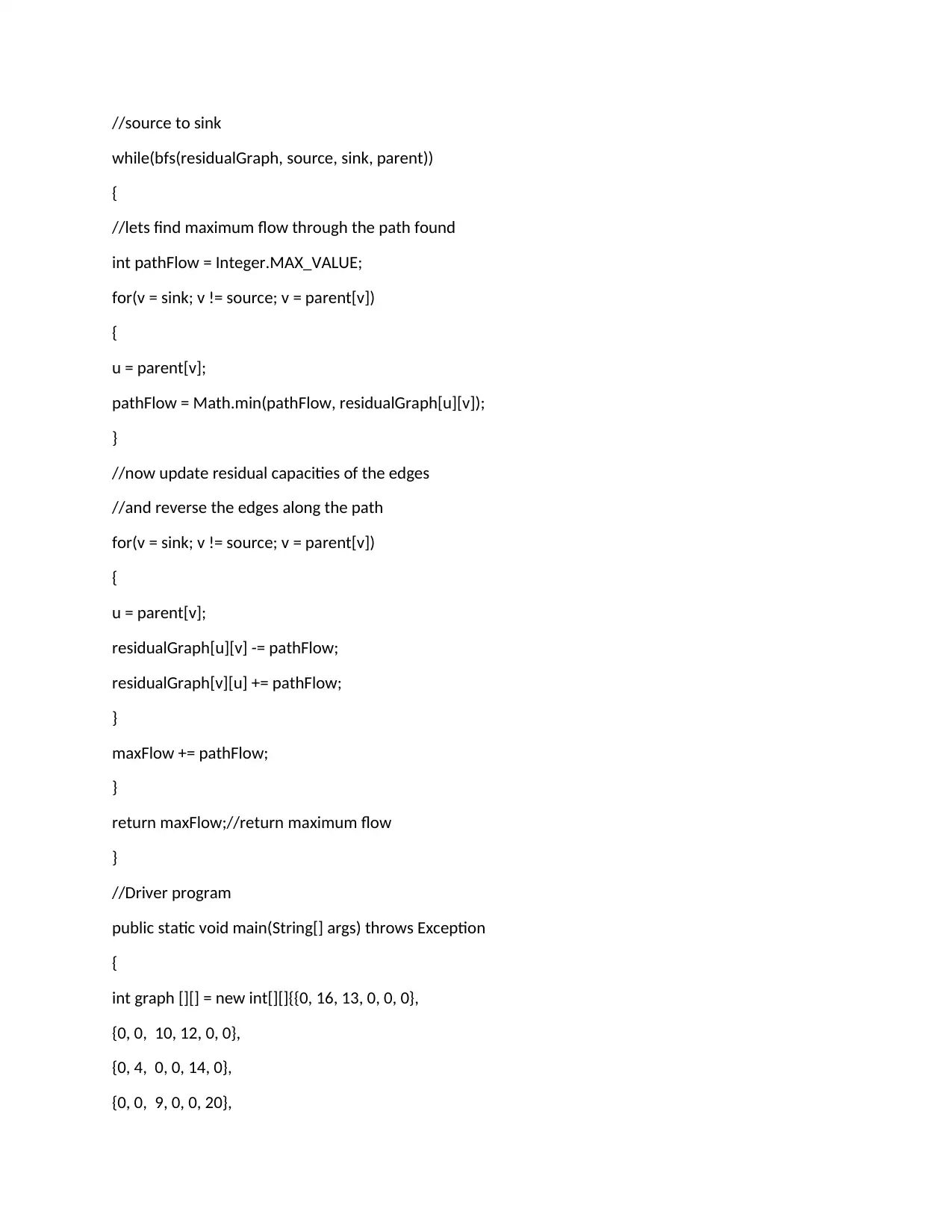
//source to sink
while(bfs(residualGraph, source, sink, parent))
{
//lets find maximum flow through the path found
int pathFlow = Integer.MAX_VALUE;
for(v = sink; v != source; v = parent[v])
{
u = parent[v];
pathFlow = Math.min(pathFlow, residualGraph[u][v]);
}
//now update residual capacities of the edges
//and reverse the edges along the path
for(v = sink; v != source; v = parent[v])
{
u = parent[v];
residualGraph[u][v] -= pathFlow;
residualGraph[v][u] += pathFlow;
}
maxFlow += pathFlow;
}
return maxFlow;//return maximum flow
}
//Driver program
public static void main(String[] args) throws Exception
{
int graph [][] = new int[][]{{0, 16, 13, 0, 0, 0},
{0, 0, 10, 12, 0, 0},
{0, 4, 0, 0, 14, 0},
{0, 0, 9, 0, 0, 20},
while(bfs(residualGraph, source, sink, parent))
{
//lets find maximum flow through the path found
int pathFlow = Integer.MAX_VALUE;
for(v = sink; v != source; v = parent[v])
{
u = parent[v];
pathFlow = Math.min(pathFlow, residualGraph[u][v]);
}
//now update residual capacities of the edges
//and reverse the edges along the path
for(v = sink; v != source; v = parent[v])
{
u = parent[v];
residualGraph[u][v] -= pathFlow;
residualGraph[v][u] += pathFlow;
}
maxFlow += pathFlow;
}
return maxFlow;//return maximum flow
}
//Driver program
public static void main(String[] args) throws Exception
{
int graph [][] = new int[][]{{0, 16, 13, 0, 0, 0},
{0, 0, 10, 12, 0, 0},
{0, 4, 0, 0, 14, 0},
{0, 0, 9, 0, 0, 20},
⊘ This is a preview!⊘
Do you want full access?
Subscribe today to unlock all pages.

Trusted by 1+ million students worldwide
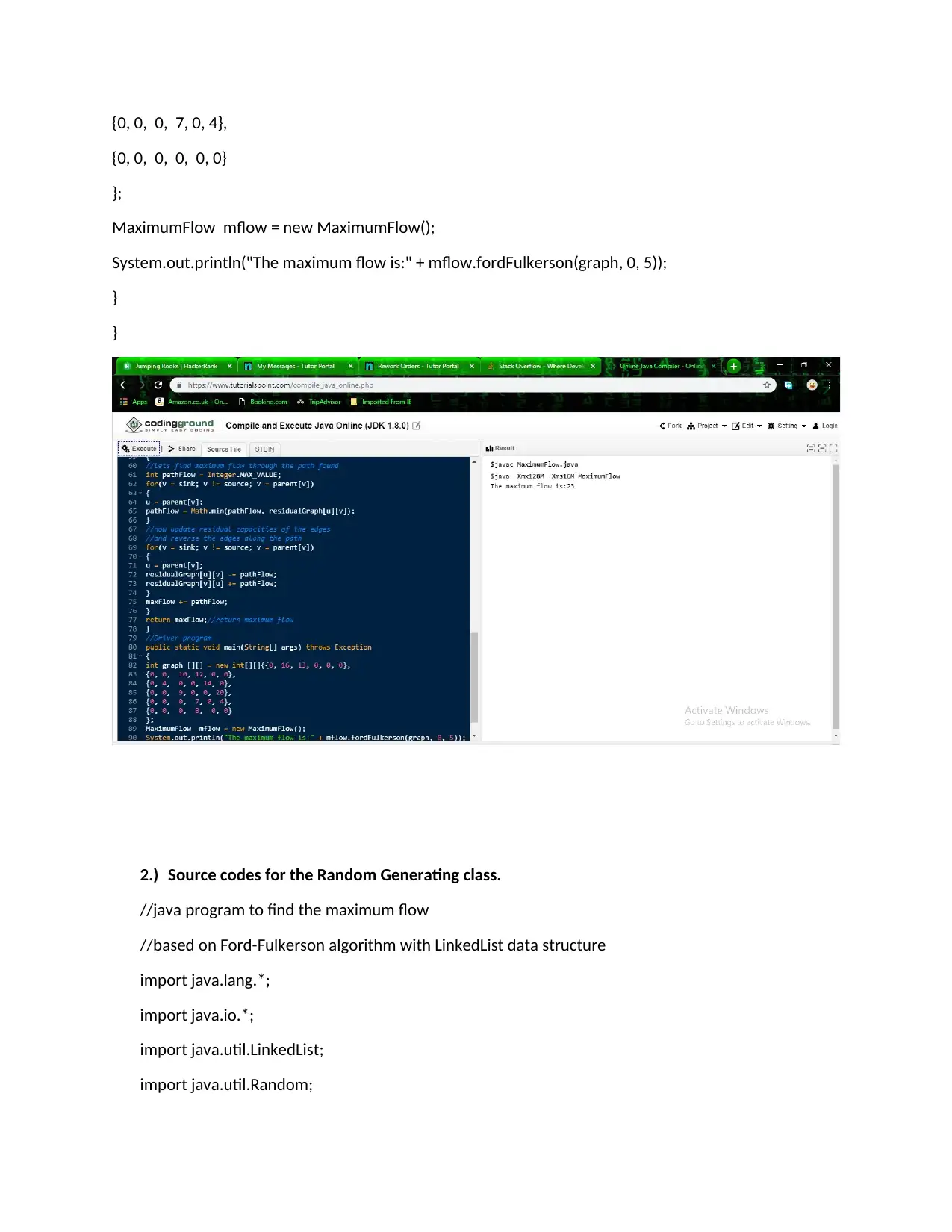
{0, 0, 0, 7, 0, 4},
{0, 0, 0, 0, 0, 0}
};
MaximumFlow mflow = new MaximumFlow();
System.out.println("The maximum flow is:" + mflow.fordFulkerson(graph, 0, 5));
}
}
2.) Source codes for the Random Generating class.
//java program to find the maximum flow
//based on Ford-Fulkerson algorithm with LinkedList data structure
import java.lang.*;
import java.io.*;
import java.util.LinkedList;
import java.util.Random;
{0, 0, 0, 0, 0, 0}
};
MaximumFlow mflow = new MaximumFlow();
System.out.println("The maximum flow is:" + mflow.fordFulkerson(graph, 0, 5));
}
}
2.) Source codes for the Random Generating class.
//java program to find the maximum flow
//based on Ford-Fulkerson algorithm with LinkedList data structure
import java.lang.*;
import java.io.*;
import java.util.LinkedList;
import java.util.Random;
Paraphrase This Document
Need a fresh take? Get an instant paraphrase of this document with our AI Paraphraser
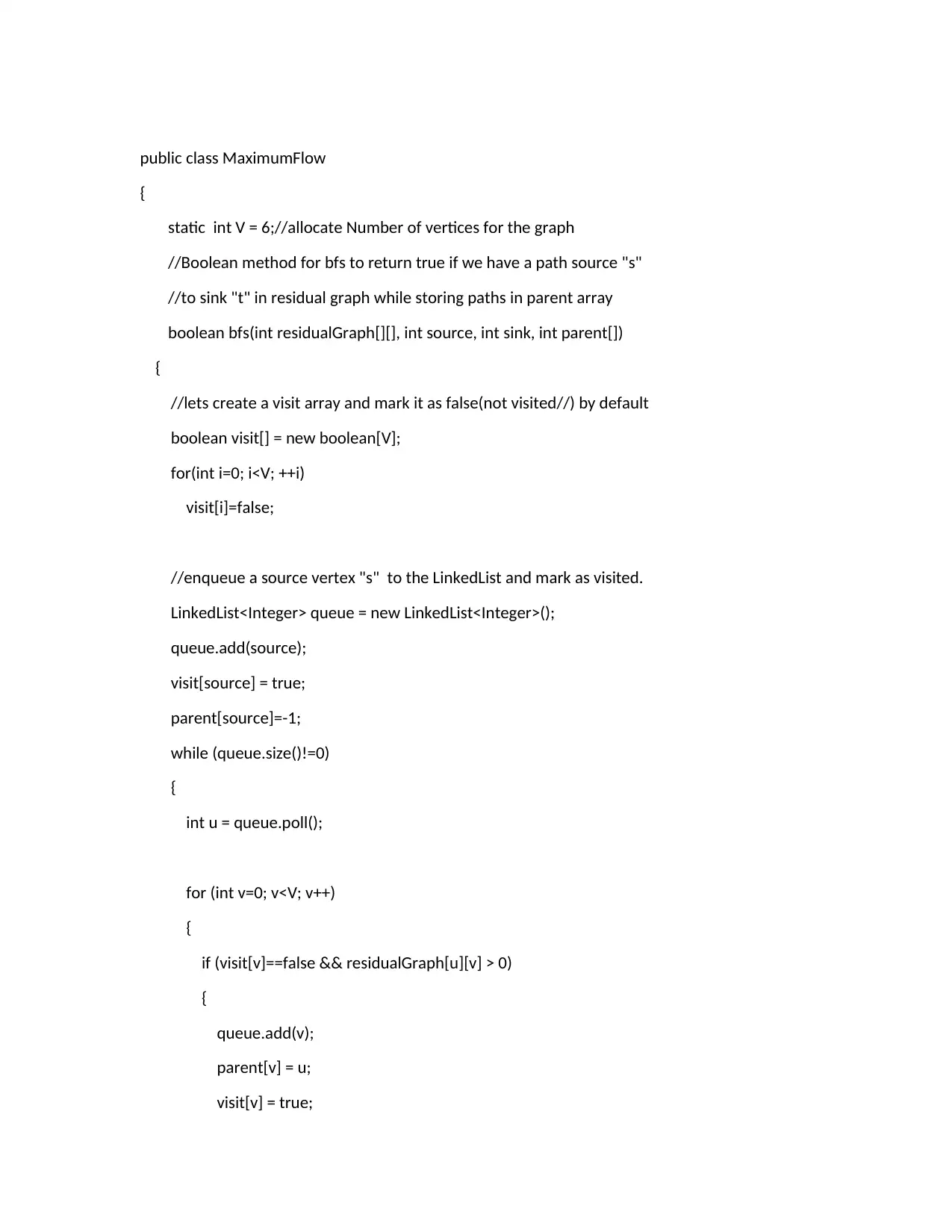
public class MaximumFlow
{
static int V = 6;//allocate Number of vertices for the graph
//Boolean method for bfs to return true if we have a path source "s"
//to sink "t" in residual graph while storing paths in parent array
boolean bfs(int residualGraph[][], int source, int sink, int parent[])
{
//lets create a visit array and mark it as false(not visited//) by default
boolean visit[] = new boolean[V];
for(int i=0; i<V; ++i)
visit[i]=false;
//enqueue a source vertex "s" to the LinkedList and mark as visited.
LinkedList<Integer> queue = new LinkedList<Integer>();
queue.add(source);
visit[source] = true;
parent[source]=-1;
while (queue.size()!=0)
{
int u = queue.poll();
for (int v=0; v<V; v++)
{
if (visit[v]==false && residualGraph[u][v] > 0)
{
queue.add(v);
parent[v] = u;
visit[v] = true;
{
static int V = 6;//allocate Number of vertices for the graph
//Boolean method for bfs to return true if we have a path source "s"
//to sink "t" in residual graph while storing paths in parent array
boolean bfs(int residualGraph[][], int source, int sink, int parent[])
{
//lets create a visit array and mark it as false(not visited//) by default
boolean visit[] = new boolean[V];
for(int i=0; i<V; ++i)
visit[i]=false;
//enqueue a source vertex "s" to the LinkedList and mark as visited.
LinkedList<Integer> queue = new LinkedList<Integer>();
queue.add(source);
visit[source] = true;
parent[source]=-1;
while (queue.size()!=0)
{
int u = queue.poll();
for (int v=0; v<V; v++)
{
if (visit[v]==false && residualGraph[u][v] > 0)
{
queue.add(v);
parent[v] = u;
visit[v] = true;
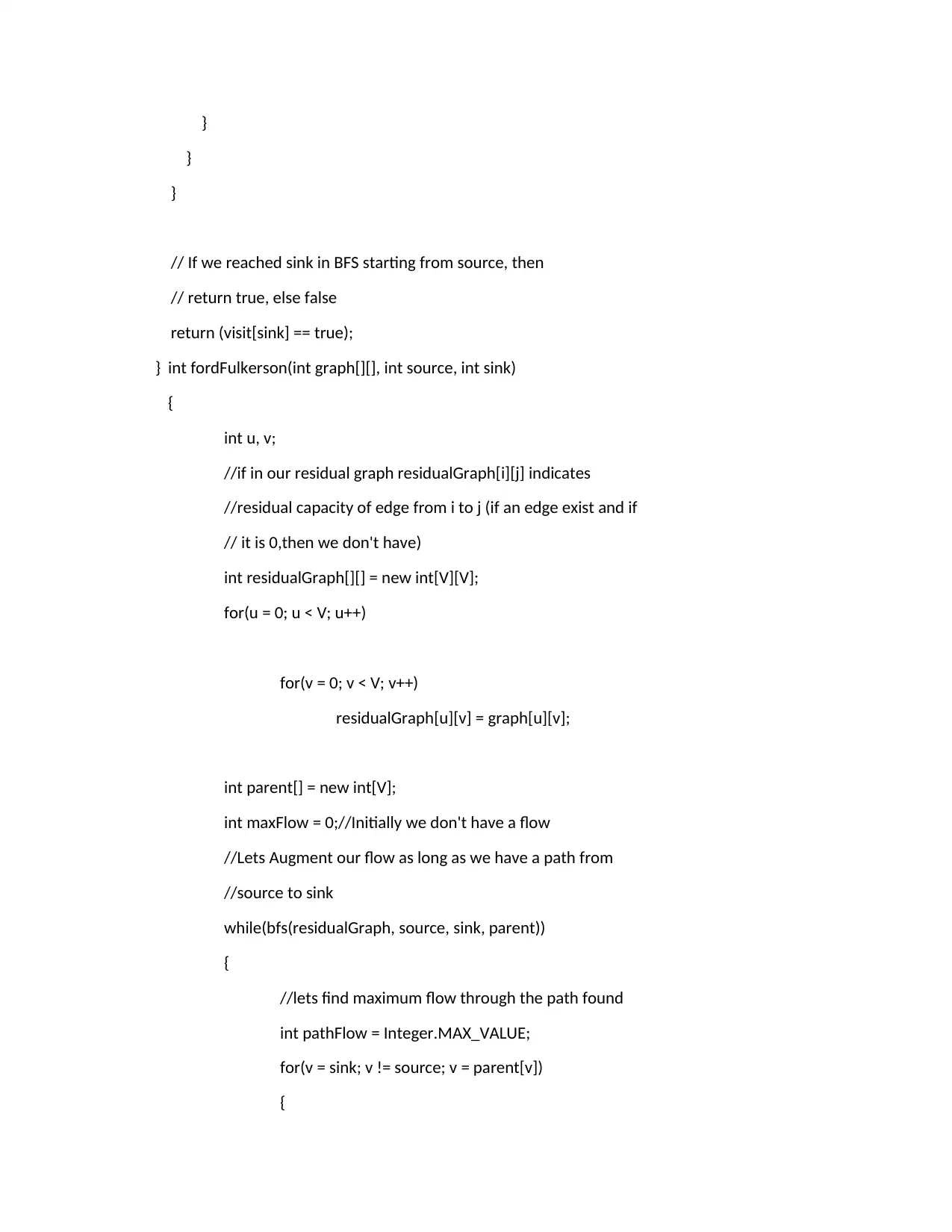
}
}
}
// If we reached sink in BFS starting from source, then
// return true, else false
return (visit[sink] == true);
} int fordFulkerson(int graph[][], int source, int sink)
{
int u, v;
//if in our residual graph residualGraph[i][j] indicates
//residual capacity of edge from i to j (if an edge exist and if
// it is 0,then we don't have)
int residualGraph[][] = new int[V][V];
for(u = 0; u < V; u++)
for(v = 0; v < V; v++)
residualGraph[u][v] = graph[u][v];
int parent[] = new int[V];
int maxFlow = 0;//Initially we don't have a flow
//Lets Augment our flow as long as we have a path from
//source to sink
while(bfs(residualGraph, source, sink, parent))
{
//lets find maximum flow through the path found
int pathFlow = Integer.MAX_VALUE;
for(v = sink; v != source; v = parent[v])
{
}
}
// If we reached sink in BFS starting from source, then
// return true, else false
return (visit[sink] == true);
} int fordFulkerson(int graph[][], int source, int sink)
{
int u, v;
//if in our residual graph residualGraph[i][j] indicates
//residual capacity of edge from i to j (if an edge exist and if
// it is 0,then we don't have)
int residualGraph[][] = new int[V][V];
for(u = 0; u < V; u++)
for(v = 0; v < V; v++)
residualGraph[u][v] = graph[u][v];
int parent[] = new int[V];
int maxFlow = 0;//Initially we don't have a flow
//Lets Augment our flow as long as we have a path from
//source to sink
while(bfs(residualGraph, source, sink, parent))
{
//lets find maximum flow through the path found
int pathFlow = Integer.MAX_VALUE;
for(v = sink; v != source; v = parent[v])
{
⊘ This is a preview!⊘
Do you want full access?
Subscribe today to unlock all pages.

Trusted by 1+ million students worldwide
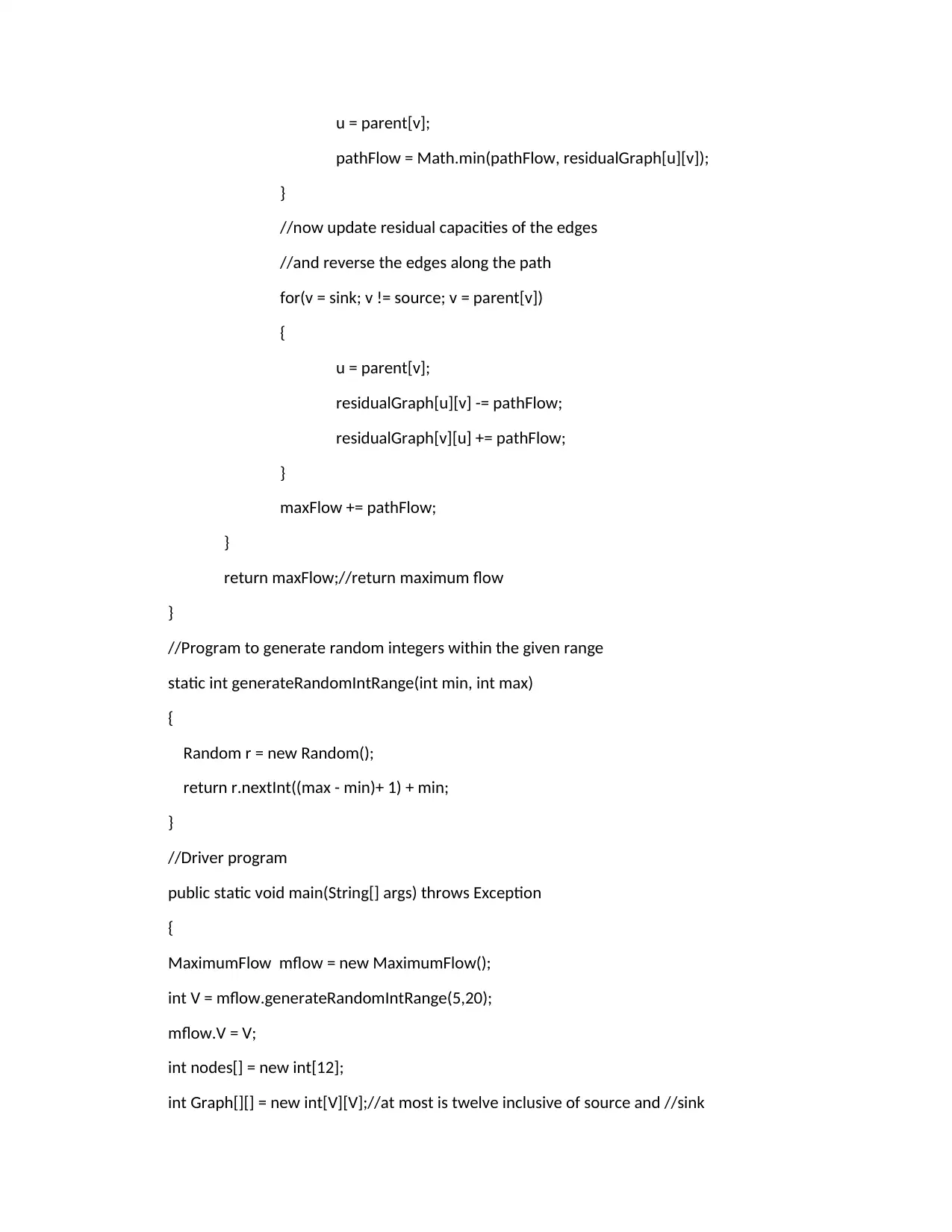
u = parent[v];
pathFlow = Math.min(pathFlow, residualGraph[u][v]);
}
//now update residual capacities of the edges
//and reverse the edges along the path
for(v = sink; v != source; v = parent[v])
{
u = parent[v];
residualGraph[u][v] -= pathFlow;
residualGraph[v][u] += pathFlow;
}
maxFlow += pathFlow;
}
return maxFlow;//return maximum flow
}
//Program to generate random integers within the given range
static int generateRandomIntRange(int min, int max)
{
Random r = new Random();
return r.nextInt((max - min)+ 1) + min;
}
//Driver program
public static void main(String[] args) throws Exception
{
MaximumFlow mflow = new MaximumFlow();
int V = mflow.generateRandomIntRange(5,20);
mflow.V = V;
int nodes[] = new int[12];
int Graph[][] = new int[V][V];//at most is twelve inclusive of source and //sink
pathFlow = Math.min(pathFlow, residualGraph[u][v]);
}
//now update residual capacities of the edges
//and reverse the edges along the path
for(v = sink; v != source; v = parent[v])
{
u = parent[v];
residualGraph[u][v] -= pathFlow;
residualGraph[v][u] += pathFlow;
}
maxFlow += pathFlow;
}
return maxFlow;//return maximum flow
}
//Program to generate random integers within the given range
static int generateRandomIntRange(int min, int max)
{
Random r = new Random();
return r.nextInt((max - min)+ 1) + min;
}
//Driver program
public static void main(String[] args) throws Exception
{
MaximumFlow mflow = new MaximumFlow();
int V = mflow.generateRandomIntRange(5,20);
mflow.V = V;
int nodes[] = new int[12];
int Graph[][] = new int[V][V];//at most is twelve inclusive of source and //sink
Paraphrase This Document
Need a fresh take? Get an instant paraphrase of this document with our AI Paraphraser
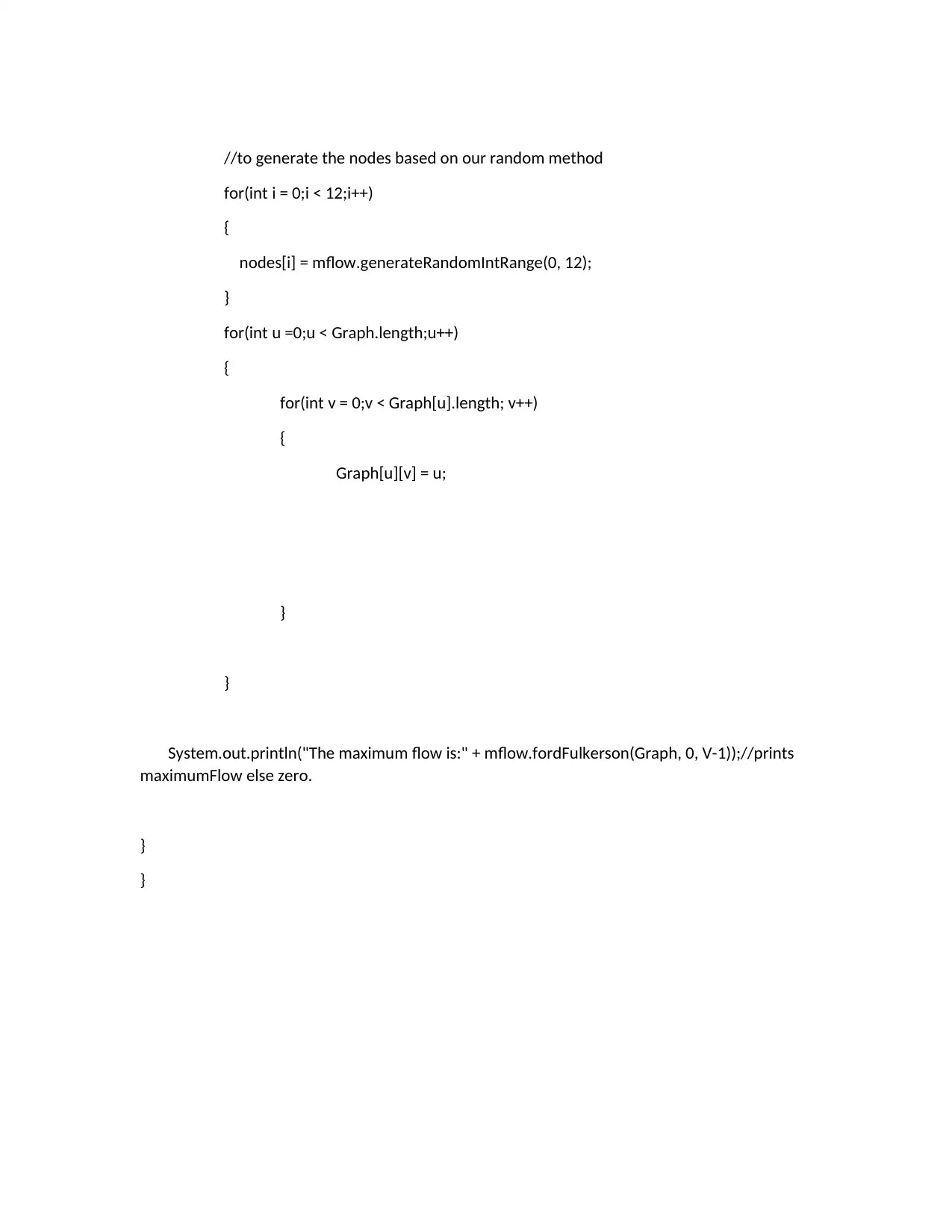
//to generate the nodes based on our random method
for(int i = 0;i < 12;i++)
{
nodes[i] = mflow.generateRandomIntRange(0, 12);
}
for(int u =0;u < Graph.length;u++)
{
for(int v = 0;v < Graph[u].length; v++)
{
Graph[u][v] = u;
}
}
System.out.println("The maximum flow is:" + mflow.fordFulkerson(Graph, 0, V-1));//prints
maximumFlow else zero.
}
}
for(int i = 0;i < 12;i++)
{
nodes[i] = mflow.generateRandomIntRange(0, 12);
}
for(int u =0;u < Graph.length;u++)
{
for(int v = 0;v < Graph[u].length; v++)
{
Graph[u][v] = u;
}
}
System.out.println("The maximum flow is:" + mflow.fordFulkerson(Graph, 0, V-1));//prints
maximumFlow else zero.
}
}

3.) Performance analysis.
The java program above implements an algorithm called Fold-Fulkerson with a LinkedList data structure.
Since it is an implementation of Edmonds-Karp algorithm, the worst time complexity is O(VE2) and an
adjacency matrix representation of O(V2), hence the above implementation has O(EV3) Time complexity.
The java program above implements an algorithm called Fold-Fulkerson with a LinkedList data structure.
Since it is an implementation of Edmonds-Karp algorithm, the worst time complexity is O(VE2) and an
adjacency matrix representation of O(V2), hence the above implementation has O(EV3) Time complexity.
⊘ This is a preview!⊘
Do you want full access?
Subscribe today to unlock all pages.

Trusted by 1+ million students worldwide
1 out of 9
Your All-in-One AI-Powered Toolkit for Academic Success.
+13062052269
info@desklib.com
Available 24*7 on WhatsApp / Email
![[object Object]](/_next/static/media/star-bottom.7253800d.svg)
Unlock your academic potential
Copyright © 2020–2025 A2Z Services. All Rights Reserved. Developed and managed by ZUCOL.

